1:準(zhǔn)備:
JDK:http://www.oracle.com/technetwork/java/javase/downloads/jdk6downloads-1902814.html
eclipse:http://www.eclipse.org/downloads/download.php?file=/technology/epp/downloads/release/juno/SR2/eclipse-jee-juno-SR2-win32.zip
tomcat:http://tomcat.apache.org/download-60.cgi
axis2:http://axis.apache.org/axis2/java/core/download.cgi
eclipse的官方提供的axis插件工具,可以打包aar文件和生成客戶(hù)端調(diào)用代碼:http://axis.apache.org/axis2/java/core/tools/index.html
其中的Service Archive Wizard - Eclipse Plug-in和Code Generator Wizard - Eclipse Plug-in
下載完成的軟件如圖1.1

圖1.1
2:配置環(huán)境:
2.1:配置java環(huán)境變量(不贅述)。
2.1:eclipse中axis2環(huán)境配置:Window->Perferences->Web Services->Axis2 perferences->Axis2 Runtime->Axis2 Runtime location,Browse選擇解壓axis2-1.6.2-bin.zip得到的axis2-1.6.2文件目錄。如圖2.1。

圖2.1
2.2:安裝插件:解壓axis2-eclipse-codegen-plugin-1.6.2.zip和axis2-eclipse-service-plugin-1.6.2.zip,把得到的兩個(gè)jar包放入eclipse目錄下的\plugins\中,重啟eclipse。
2.3:配置tomcat:解壓apache-tomcat-6.0.36-windows-x64.zip(不贅述)。
2.4:eclipse中tomcat配置:Window->Perferences->Server->Runtime Environments添加。
3:發(fā)布axis2:
3.1:解壓axis2-1.6.2-war.zip獲得axis2.war并把它放到tomcat解壓目錄的webapps文件夾下,啟動(dòng)tomcat,瀏覽器中輸入http://localhost:8080/axis2/,出現(xiàn)圖3.1,說(shuō)明配置成功。

圖3.1
3.2:用eclipse的axis2插件發(fā)布web服務(wù)。
3.2.1 在eclipse中new一個(gè)Dynamic Web Project,取名webserviceService。編寫(xiě)一個(gè)簡(jiǎn)單的webService服務(wù)器代碼
1 package org.web.service;
2
3 public class HelloWorldService {
4 public String sayHello(String name){
5 return "Hello," + name;
6 }
7 }
8
3.2.2 在eclipse的空白workspace處,右鍵new->Other,在彈出的對(duì)話(huà)框中,找到Axis2 Service Archiver,雙擊->選擇HelloWorldService所在項(xiàng)目的class路徑,如圖3.2

圖3.2
next->選中skip WSDL,Next->什么都不填NEXT->選中Generate the service xml automatically,NEXT->

圖3.3
如如圖3.3填寫(xiě)
HelloWorldService類(lèi)的全路徑,點(diǎn)擊load,在下面的Method表中出現(xiàn)sayHello說(shuō)明load成功,點(diǎn)擊NEXT->
圖3.4
填寫(xiě)Output file location,點(diǎn)擊Finish,如圖3.4。
3.2.2 右鍵點(diǎn)擊webServiceService項(xiàng)目,刷新。出現(xiàn)my_service.aar文件,如圖3.5。

圖3.5
把此aar文件放到%tomcat_home%\webapps\axis2\WEB-INF\services下。瀏覽器中輸入http://localhost:8080/axis2/services/HelloWorldService?wsdl,出現(xiàn)圖3.6,說(shuō)明發(fā)布成功。

圖3.6
4:用eclipse的Web Service Client生成客戶(hù)端調(diào)用代碼。
4.1:在eclipse的空白workspace處右鍵new->Other->Web services->Web Service Client,選中,點(diǎn)擊NEXT->出現(xiàn)圖4.1
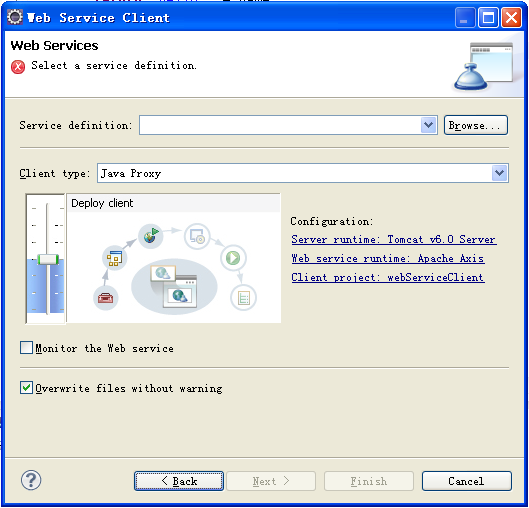
圖4.1
service definition填發(fā)布好的wsdl路徑http://localhost:8080/axis2/services/HelloWorldService?wsdl,Client type默認(rèn),下面的下滑快拉到最上面,點(diǎn)擊Server runtime:Tomcat v6.0 Server出現(xiàn)圖4.2:
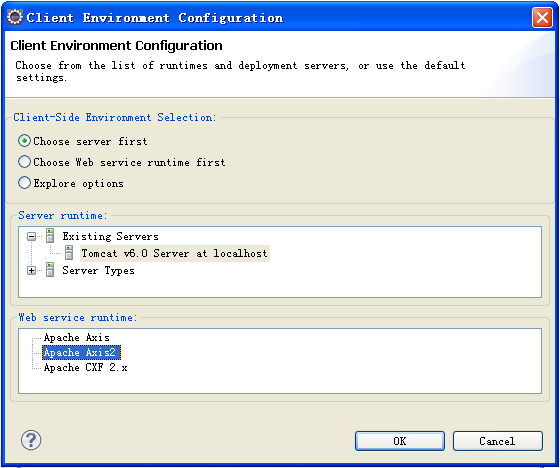
圖4.2
在Server runtime中選擇默認(rèn),Web service runtime選擇Apache Axis2,點(diǎn)擊Ok,返回圖4.1,點(diǎn)擊Client project:webServiceClient,出現(xiàn)圖4.3
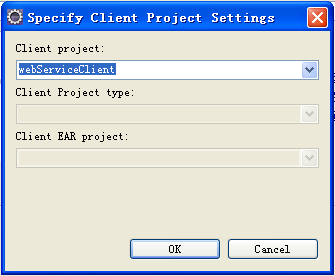
圖4.3
在Client project的下拉列表中選擇客戶(hù)端代碼存放的項(xiàng)目,本例選擇webServiceClient。點(diǎn)擊OK,返回圖4.1,點(diǎn)擊NEXT,進(jìn)入下一個(gè)環(huán)節(jié),然后點(diǎn)擊Finish。
,

圖4.4
如圖4.4,在src的source folder下出現(xiàn)org.web.service包,下面有HelloWorldServiceCallBackHandler.java和HelloWorldServiceStub.java文件,Web App Libraries也有更新,在WebContent目錄下也出現(xiàn)axis2-web文件夾,以及WEB-INF等的更新。
4.2:寫(xiě)webService調(diào)用代碼。
在webServiceClient項(xiàng)目中新建一個(gè)客戶(hù)端測(cè)試文件如下:
1 package org.web.client;
2
3 import java.rmi.RemoteException;
4
5 import org.web.service.HelloWorldServiceStub;
6 import org.web.service.HelloWorldServiceStub.SayHelloResponse;
7
8 public class HelloWorldClient {
9
10 /**
11 * @param args
12 * @throws RemoteException
13 */
14 public static void main(String[] args) throws RemoteException {
15 String target = "http://localhost:8080/axis2/services/HelloWorldService";
16 HelloWorldServiceStub stub = new HelloWorldServiceStub(target);
17 // sayHello 為webService提供參數(shù)
18 HelloWorldServiceStub.SayHello sayHello = new HelloWorldServiceStub.SayHello();
19 sayHello.setName("jackii");
20 SayHelloResponse eur = stub.sayHello(sayHello);
21 String returnVal = eur.get_return();
22 System.out.println(returnVal);
23 }
24
25 }
運(yùn)行上面代碼Run As->Java Application,輸出:
Hello,jackii
說(shuō)明調(diào)用成功。
5:參考文檔http://wenku.baidu.com/view/12501ed7195f312b3169a54b.html
6:服務(wù)端接收的參數(shù)為javaBean,返回list樣例:
6.1:創(chuàng)建服務(wù)。新建User.java
1 package org.web.service;
2
3 public class User {
4 private String id;
5 private String name;
6 public String getId() {
7 return id;
8 }
9 public void setId(String id) {
10 this.id = id;
11 }
12 public String getName() {
13 return name;
14 }
15 public void setName(String name) {
16 this.name = name;
17 }
18 }
19
ListService.java
1 package org.web.service;
2
3 import java.util.ArrayList;
4 import java.util.List;
5
6 public class ListService {
7 public List<User> getUserList(User user){
8 List<User> returnList = new ArrayList<User>();
9 returnList.add(user);
10 for(int i=0;i<3;i++){
11 User user1 = new User();
12 user1.setId("00"+i);
13 user1.setName("jack00"+i);
14 returnList.add(user1);
15 }
16 return returnList;
17 }
18 }
文件目錄如圖6.1:
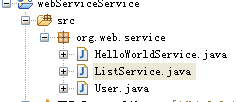
圖6.1
按照3.2說(shuō)明重新發(fā)布服務(wù)(圖3.4Output File Name重新起個(gè)名字)
6.2:創(chuàng)建客戶(hù)端調(diào)用代碼,步奏同4。得到圖6.2所示兩個(gè)文件ListServiceStub.java和ListServiceCallbackHandler.java
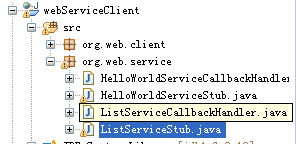
圖6.2
創(chuàng)建ListServiceClient.java
1 package org.web.client;
2
3 import java.rmi.RemoteException;
4
5 import org.web.service.ListServiceStub;
6 import org.web.service.ListServiceStub.GetUserListResponse;
7 import org.web.service.ListServiceStub.User;
8
9 public class ListServiceClient {
10
11 /**
12 * @param args
13 * @throws RemoteException
14 */
15 public static void main(String[] args) throws RemoteException {
16 String target = "http://localhost:8080/axis2/services/ListService";
17 ListServiceStub stub = new ListServiceStub(target);
18 ListServiceStub.GetUserList getUserList0 = new ListServiceStub.GetUserList();
19 User user = new User();
20 user.setId("clientTest");
21 user.setName("ClientName");
22 getUserList0.setUser(user);
23 GetUserListResponse eur = stub.getUserList(getUserList0);
24 User[] userArray = eur.get_return();
25 for(int i=0;i<userArray.length;i++){
26 System.out.println("id:"+userArray[i].getId()+"name:"+userArray[i].getName()+"\n");
27 }
28 }
29 }
以java application方式運(yùn)行,輸出:
1 id:clientTestname:ClientName
2
3 id:000name:jack000
4
5 id:001name:jack001
6
7 id:002name:jack002
說(shuō)明調(diào)用成功。

 圖1.1
圖1.1 圖2.1
圖2.1 圖3.1
圖3.1 圖3.2
圖3.2 圖3.3
圖3.3 圖3.4
圖3.4 圖3.5
圖3.5 圖3.6
圖3.6 圖4.1
圖4.1 圖4.2
圖4.2 圖4.3
圖4.3 圖4.4
圖4.4 圖6.1
圖6.1 圖6.2
圖6.2